Oct 22, 2013 | Management |

The great thing about a good model is that it is extensible. The Craftsperson model, which can be used for personal or team management, can also be extended and applied to manage a cross-functional, multi-disciplinary group.
The framework can be used in a number of ways, but we’ll discuss a couple here:
- A simple overview of the group structure
- A basis for career transition conversations
Craftspeople Management Framework
As always, it’s best to discuss this with an illustration. Here’s an example of the framework depicting a technology group with multiple teams – although note that it can be used to represent any function within an organisation:
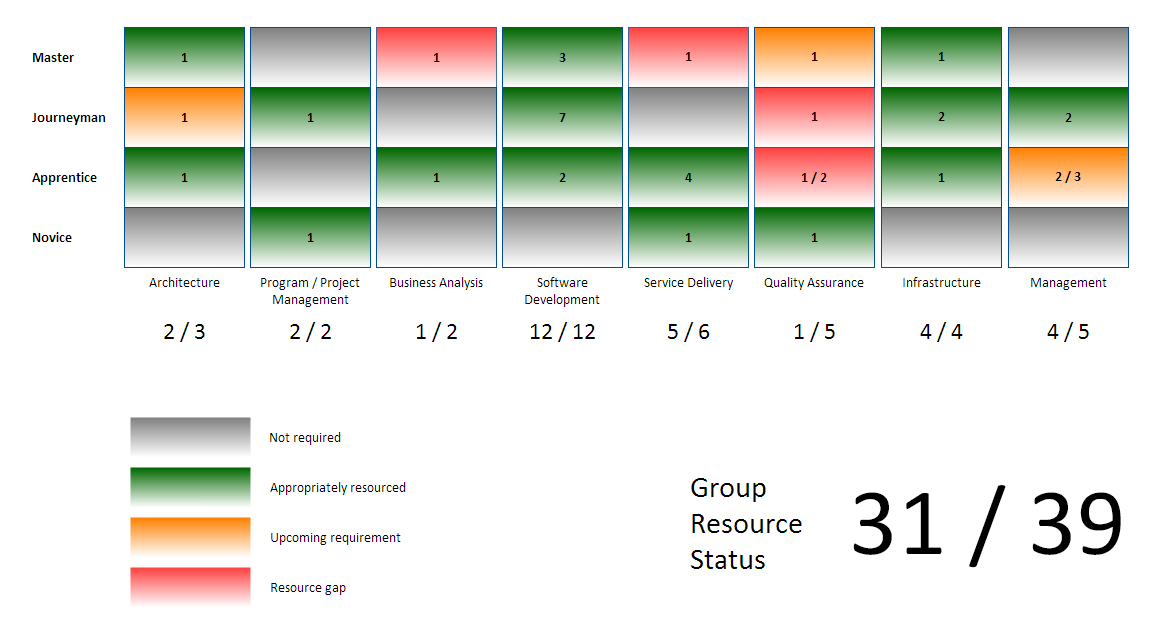
While this might look a little complicated and busy, remember that this fictitious group consists of eight teams and 31 people – a necessarily complex environment.
Let’s talk about some of the elements of the framework in a little more detail, and then pull it all together.
Overall group status
The overall Group Resource Status counter indicates how well the group is staffed. The thresholds at which you may start to get alarmed are unique to you and your organisation, but it provides an easy, at-a-glance understanding of whether a recruitment drive should be considered.

Practices
Each column represents a discrete Practice within the group. Practices can be structured in whatever way makes sense to an organisation, but represents a stand-alone area of focus and a fairly standard career path for most people.
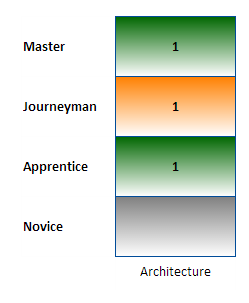
This was discussed in some detail in previous posts. Note that Practices don’t necessarily have to mean teams. Teams can consist of individuals from multiple Practices.
Practice Status
Indicates how well an individual Practice is resourced:

Obviously QA needs some attention.
Colour key
The colour key indicates the status of each stage within a Practice.
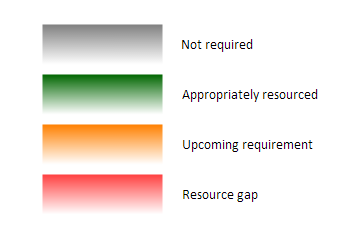
Gray – The stage is not required, based on the organisation or group’s current operating environment. For example, in the image above the Master stage in Program / Project Management is at “Not Required”. This could be because there are no major programs running, the program or project management is out-sourced, or perhaps even handled by other functions within the company. Similarly, the Novice stage in Software Development is set to “Not Required”, which could be because of policy to only hire slightly experienced software developers rather than fresh graduates who require lots of management attention.
Green – All is well. Nothing to see here folks. Go back to your desks and carry on.
Orange – There is no great urgency, but a need for one or more resources operating at this level has been identified. This should result in conversations about promoting within the ranks if the skills exist, or starting to engage the appropriate recruitment functions.
Red – Houston, we have a problem. A resource gap exists that is impacting current delivery of initiatives, and needs to be addressed urgently.
Resource count
The number in the box for each stage. A single number indicates the resource count (or requirement, in the case of orange or red status):

Alternatively, a fraction in a box indicates an existing or upcoming resource gap. Obviously this can only be an orange or red box:

Bringing it all together – The Framework in action
Okay, so let’s pull it all together and discuss a couple of uses of the framework.
Group Overview
Here is the visualisation of the fictitious group again, and the overview we can glean from it:

- This is a reasonably sized group of 31 technologists.
- The group is structured into 7 distinct Practices, along with management.
- The software development function has a large representation, indicating the overall focus of activities within this group.
- There is a gap of 8 resources to get this group to its target operating effectiveness. 4 of these are required urgently.
- The Quality Assurance Practice is significantly under-resourced.
The visualisation of the framework very quickly lets us understand the group structure and focus, as well as its resourcing health.
Career Transition Conversation
Another useful thing about this framework is that it enables conversations about what career paths may be possible. In our example, let’s pick someone from the Service Delivery Practice – say, an Application Support Analyst – who is at the Apprentice level. They realise that they are starting to mature past their current stage, but there are no current positions available at the next level. They also really want to transition into Project Management:
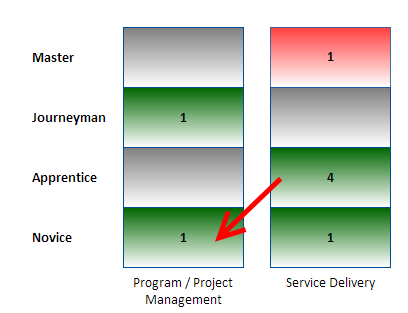
The framework allows a meaningful conversation to take place. If they have demonstrated the appropriate attitude and aptitude, they would be first in line for the Novice Project Manager role when it is vacated, or more likely, a role would be created for them.
Management as a Practice
One final point: note that I have included Management as a Practice. Just like the rest of the (IT) crafts, management requires following a learning path and growing through the stages. It needs clearly defined levels, with behaviours and measurable metrics to determine progress. Getting promoted into management doesn’t mean you’ve made it. It means you’re a novice just getting started.
Oct 18, 2013 | Career, Management |

While it’s great to approach your profession as a craft and adopt a general model of craftsmanship, the next level of rigour requires adding some frameworks to ensure measurability and progress assessment. Again, this is great at a personal level, but also adds immense value from a team management perspective.
To enable the introduction of a framework, lets take the general model introduced earlier and collapse it into a column vector:
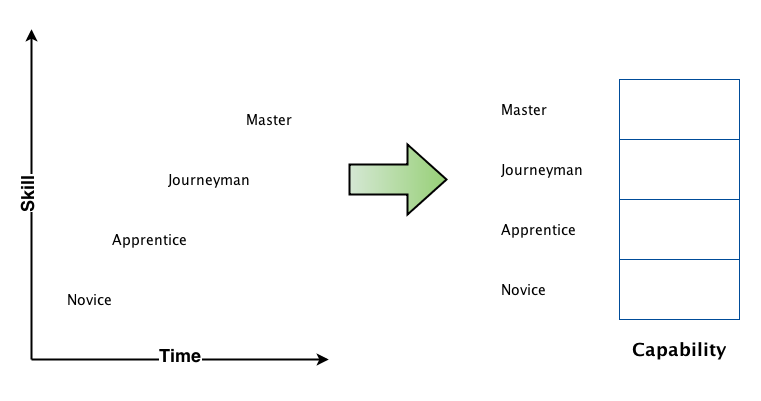
At this level of abstraction you can see the inherent flexibility in this framework – you can pretty much extend it to add as much or as little complexity as you want or your environment warrants. Here’s an example:

If you wanted to (or had to), you could even overlay this on something like the Australian Public Service Commission’s Integrated Leadership System:
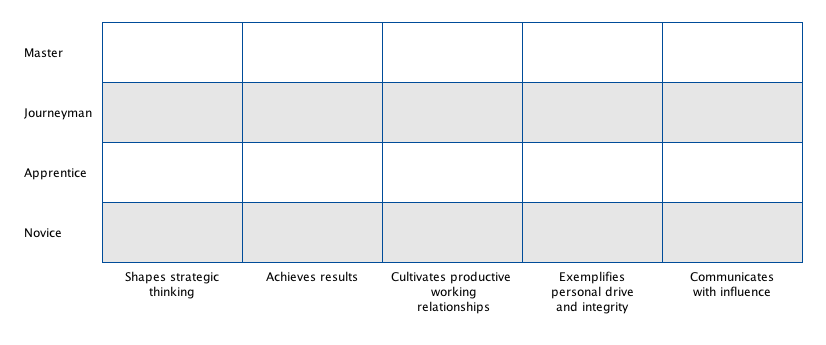
Note that’s only at the top level of the ILS. You can keep drilling down and add more detail as required. Having said that, the ILS is seriously well developed and documented (as one would expect from a Government Department), so I wouldn’t necessarily do it at any detailed level if I worked at an Agency using it. Just pointing out that the framework can be used even where a complex performance management model already exists.
If you were to use it personally, you can just sit down and fill the matrix to map out what you needed to do to get to the next level. For a team, either the manager or the team could build this out, with clear expectations around what operating at each level means and an easy representation for discussion.
In any case, there you have it: how to use the craftsperson model with a formalised framework to introduce metrics and measureability. Enjoy.
Oct 8, 2013 | Events, Management |
The AGSM have really cranked their game up this year. Lot’s of events – networking evenings, Learn@Lunch (basically you show up with your lunch and listen to / discuss a topical management issue with a senior academic), Meet The CEO and various other learning / socialising opportunities.
So when the invite for their most recent evening event called “The Core Incompetence of the Corporation: Where and Why Things Go Wrong in Business” presented by Dr Jules Goddard showed up in my inbox, it was definitely worth delaying dinner for. Dr. Goddard is a current Fellow of London Business School and AGSM Unilever Distinguished Visitor, and an altogether entertaining and thought-provoking speaker.

Geeky academic digression:
The name of the presentation is a play on “The Core Competence of the Corporation” the game-changing and popular 1990 Harvard Business Review article by the late C.K. Prahalad and Gary Hamel, which broadly posits that organisations need to develop and focus on their core competencies – the things that they do really well and potentially uniquely – to build and maintain a sustained competitive advantage.
The basis of Dr. Goddard’s presentation was his recent book Uncommon Sense, Common Nonsense: Why some organisations consistently outperform others, which challenges most (all?) of the current popular organisational management theories. The key proposition of the book and the presentation was that incompetence is easier to articulate than competence, and therefore a better mechanism to learn from. Rather than accepting that there is a correct way of doing things, Dr. Goddard suggests that we should recognize that this is a manifestation of a systemic error or bias in most current management thinking.
I won’t outline the whole lecture because it’s probably better to read the book for that, but I did take away some interesting ideas:
- Success in business is not a pattern, and therefore impossible to theorize.
- It is also not like cooking, where a formula can be used. It is more like chess, where mastery is gained by studying half-played games and determining how to proceed from there.
- Measure the “spirit of the workforce” rather than some of the usual financial and operational metrics to determine how the organization is placed, and working on making it an extraordinary place where ordinary people can do exceptional things.
Dr Goddard also pulled out some gems from the book that had the booked-out hall laughing out loud:
- Best practice:- the recipe for formulaic sameness
- Operational excellence: doorknob polishing
- Balanced scorecards: the bureaucrats revenge
- Performance targets: insults for the conscientious
- Annual budgets: the pathology of under-ambition
- Financial incentives: bribes for loners and cynics
- Organisational alignments: the fear of diversity
- Shared values: the extinction of individualism
- Professional standards: box-ticking for the risk-averse
- Charismatic leadership: narcissism unbound
All-in-all, it was a very engaging and provocative session, and it’s clear why Dr Goddard is highly regarded as an authoritative international management strategist and thinker. As my friend George Powell commented while we were leaving – for someone who is so anti-establishment, he sure is well read on the establishment.
I’m looking forward to reading the book (and might post a review if I get the time). Thanks AGSM, and well done on hosting Dr. Goddard and providing the opportunity to hear his ideas firsthand.
The audio recording of the presentation can be found at https://soundcloud.com/asbunsw/jules-goddard-presentation.














